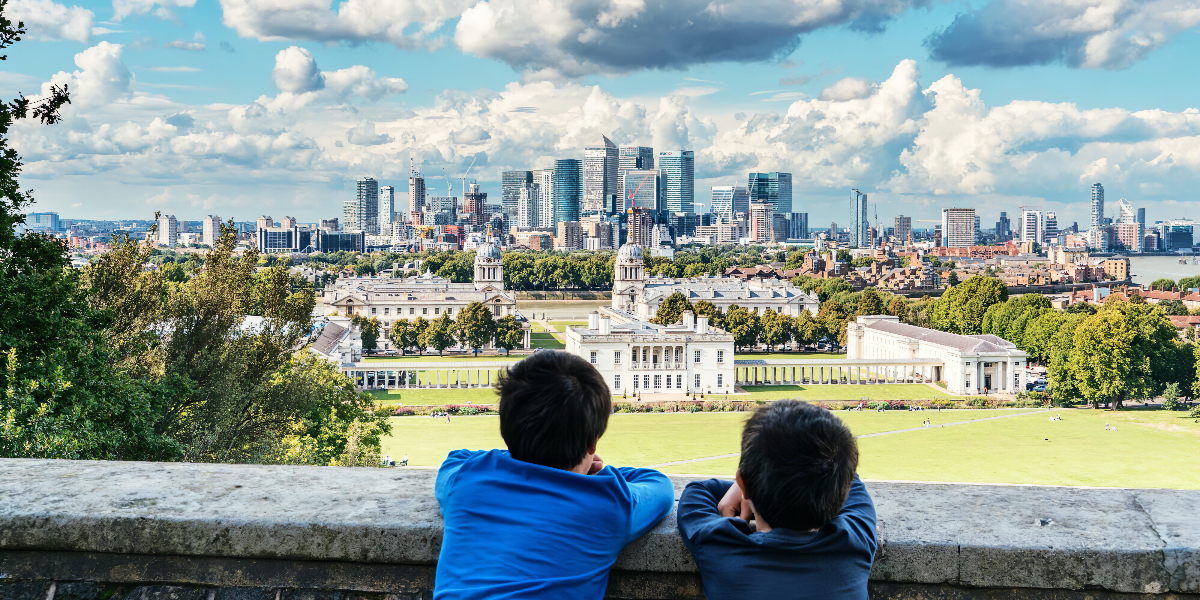Des Fitzgerald is a professor of medical humanities at University College Cork in Ireland. He has been named a “New Generation Thinker” by the BBC and the Arts and Humanities Research Council.
Below, Des shares five key insights from his new book, The Living City: Why Cities Don’t Need to Be Green to Be Great. Listen to the audio version—read by Des himself—in the Next Big Idea App.

1. The future of the city is kind of retro.
Currently, there’s an urban project called Telosa. It’s led by a highly successful entrepreneur named Marc Lore, and it’s a project to build a new city from scratch somewhere in the United States. The folks behind this have noticed that our existing cities are not working as well as we want them to. They’re not sustainable or efficient, and inequality is abundant.
The city is often not a nice place to be. It’s not welcoming. It’s not inclusive. It’s often stressful. The project is underpinned by an economic philosophy called equitism. Once you start developing an area of land, the value of that land goes up quite a lot. Under equitism, instead of this new value going to the individual or corporation who owns the land, it goes into a collective endowment held by the community. The money earned by that endowment goes back into the community for projects like healthcare, education, and so on.
Marc Lore says the inspiration behind this idea came from Victorian economist Henry George. Henry George was also the inspiration behind a much older and much more famous urban renewal project called the Garden City Movement, which began in England at the end of the 19th century and then spread around the world. The Garden City Movement and Telosa share a similar motivation to build greener, more natural, sustainable urban spaces.
I visited one of the cities established by the Garden City Movement, called Welwyn Garden City. It still exists today, not far from London. It’s remarkable how similar our vision of the urban future in 2023 is to what people were envisioning and attempting 150 years ago in a completely different world. I think it might be a problem that our vision of the urban future is actually retro. It’s rooted in the economic and social thinking of the 19th century.
Maybe we don’t have much of an urban future at all. Maybe looking forward we see a backward step in our concept of what is a city, about nature, about fairness, and about what a good human life looks like.
2. We talk a lot about nature, but we don’t always know what that means.
An idea that many of us have is that nature is good, we need more of it, and we need to be in contact with nature. It’s good for us. It keeps us calm and rested. For a lot of people, getting into nature is a mood booster.
Evolutionary biologist Edward O. Wilson established the concept of biophilia. Biophilia is the idea that because of our evolutionary inheritance, humans have a deep unconscious affiliation with living things. And that this has a lot to do with the much more natural environment that humans lived in before our fairly recent urbanization. But I say there’s nothing unnatural about the city. There’s no good reason for saying that concrete (which is a very old substance made entirely from natural materials) is any less natural than wood. There’s no reason to say that the lovely, warm, insulated tower block constructed entirely from materials that we humans found around us is less natural than a treehouse. The idea that a tower block isn’t nature is not particularly philosophically or physically respectable. It’s just a weird cultural prejudice.
“There’s no reason to say that the lovely, warm, insulated tower block constructed entirely from materials that we humans found around us is less natural than a treehouse.”
What if what we call nature isn’t a kind of thing, it’s not a substance or an environment, rather it’s a moral idea we have about the world. It’s a name we have for the idea that the way we live now is not good, that we are out of balance ecologically and psychologically.
What if we start to separate the idea from the stuff? What if we stop trying to solve our many crises with a story called nature? What if we give up on bad concepts, like biophilia? Then maybe we could think better and more robustly about what world we actually want to live in.
3. The relationship between mental health and the city is complicated.
We’ve known since at least the mid-19th century that there’s a relationship between urban space and mental health. There’s something about the city experience that can turn into a major health crisis for some people. Ever since psychiatrists and epidemiologists started producing statistics about mental illness based on populations in early asylums, we’ve known that living in a city, being born in a city, or moving to a city, all increased the risk of mental illness.
In 1939, sociologists Robert Faris and Warren Dunham mapped the rates of different psychiatric diagnoses across various neighborhoods in Chicago. They showed that, for example, social disintegration in a particular neighborhood mapped pretty closely with the incidence of psychosis. But we don’t know why any of this is as such, despite more than a century of research. More recently, people have turned to the physical environment as an explanation.
There’s a lot of research arguing that the relative absence of natural material in cities is causing this problem. It’s undoubtedly the case that there is a strong, possibly causal role between urban life and mental illness for many people, but there is nothing essential about the city that causes this. There’s no unique quality of “cityness” that has this effect on people. But those trying to pinpoint a city factor to blame are looking at contact with green space. Though it’s a nice story, it’s surely less of a distress factor than things like insecure housing, precarious employment, work pressure, inequality, and a sense that life is struggle.
I worry that when we tell people in cities to look after their health by taking their lunch break in a park or buying a plant for their office, then we’re turning away from the boring, hard, complicated social problems that lots of people (especially the powerful and wealthy) don’t want us to look at. It’s easier and cheaper to tell people to visit a forest on the weekend than legislate for minimum work contracts or build mass social housing.
There are big debates to be had about all of that, but at a minimum, if we want to take the relationship between mental health and urban stress seriously, we need to stop talking about trees.
4. Your architectural preferences are political.
There’s an experimental extension to a town called Dorchester, in the west of England, and that extension is called Poundbury. It’s built on land owned by the Duchy of Cornwall and is intellectually driven by the one-time Duke of Cornwall, the man we now know as King Charles III.
Since the 1980s, Charles has been a major public opponent of modern architecture. For example, he favors the kind of streetscape that would have been built in England in the early 1800s. A nice, modest, symmetrical human-scale Georgian terrace. Charles believes that architecture affects well-being. Maybe it’d be better to say there is an argument that architecture affects the soul.
“What imagines itself as an aesthetic argument about style or maybe a health argument about architecture and wellbeing is really a political argument.”
Some say modern architecture is soulless, boring, and not built for people. It has abandoned the accumulated knowledge and wisdom that architects built up over centuries. From there, you get to the claim that traditional or classical styles make us feel better; they’re nicer to be in. They might even make us into better kinds of people. What imagines itself as an aesthetic argument about style or maybe a health argument about architecture and wellbeing is really a political argument. It’s an argument about the social and economic values expressed by our built environment. This was described with admirable clarity by the conservative philosopher Roger Scruton in the 1970s. Scruton was an incredibly influential opponent of modern architecture, which, in his view, was not just bad or ugly; it was immoral.
I think we need to start hearing people who talk about traditional style as also talking about traditional morality—possibly making a conservative argument in favor of the hierarchical, unequal, even undemocratic social and political arrangements held throughout much of the world before the 20th century. People can make that case, but those who don’t like that need to start taking the built environment seriously. We need to start appreciating the architectural fabric of the modern world because that fabric symbolizes, contains, and holds modern values—things like the welfare state, mass housing, democratization, consumerism, diversity, and fun. There’s an architectural politics all around us.
5. Urban utopia is a bad idea.
When I first went to Welwyn Garden City, which is basically a wealthy suburb, I remember thinking this is certainly a utopia, but whose utopia is not exactly clear. The social and economic vision of the Garden City Movement is long gone, and what’s left in its place is a symbolically gated enclave for the rich. Roads lined with SUVs and big cars. Premium laneways full of nice housing. The bad idea that people like Ebenezer Howard, the founder of the Garden City Movement, had and the bad idea that we still have today is that the city is a technology for fixing the world. That there’s some kind of horizon of collective social and psychic repair when we fix our buildings, plan some modest housing estates, and put green stuff on the roof. There’s a fantasy that physical environment and architecture hold the recipe for a good society—a kind of royal road to a better future.
You see this in the large-scale greening of cities like Paris. You see it in the idea at the 15-minute city. You see it in planned new cities and towns from Saudi Arabia to provincial England. What would be different though if we set these visions aside and learned to love the real places we have now, in all their mess, diversity, confusion, and yes, even their inequality and stress? That doesn’t mean giving up on improvement, but it does mean no longer postponing the future to something that’s never going to happen. The Living City is an argument for the here and now. It’s an argument for the small and local, the dysfunctional and the weird. It’s an argument for the kinds of places that many of us currently live: places that many of us love, places that maybe just don’t need to be fixed.
To listen to the audio version read by author Des Fitzgerald, download the Next Big Idea App today:
































